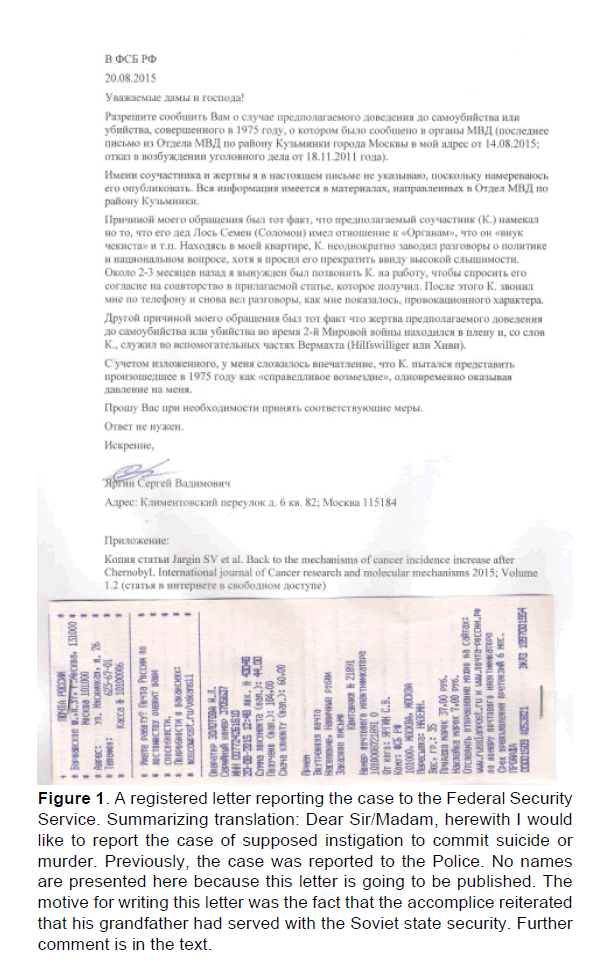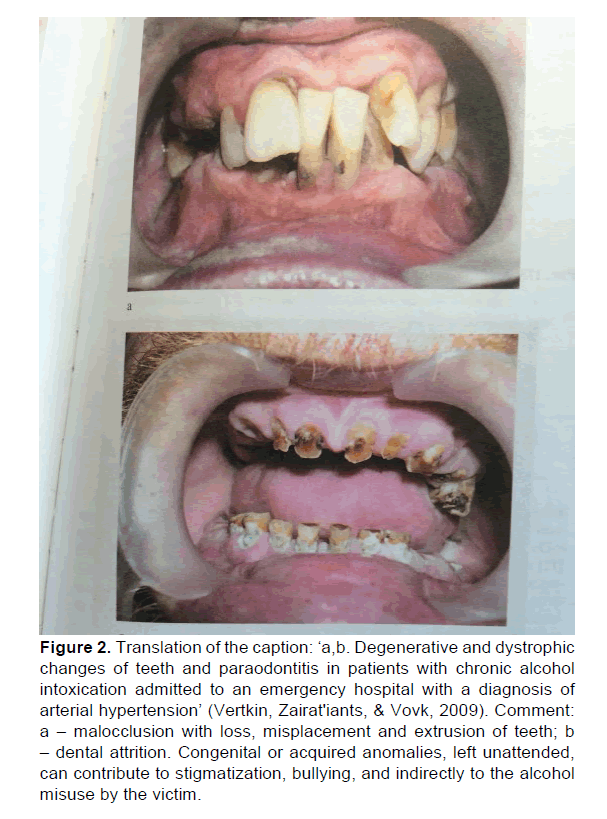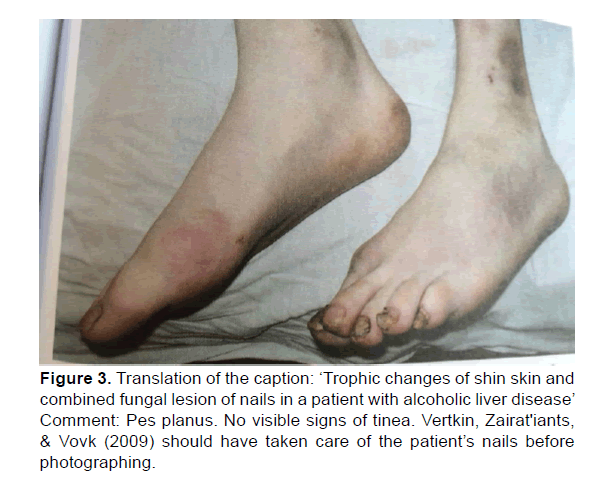Letter to Editor Open Access
Elder Abuse, Manipulation towards Suicide, and Homicide : Borders Can be Vague
Sergei V. Jargin*
Peoples’ Friendship University of Russia, Clementovski per 6-82; 115184 Moscow, Russia
- *Corresponding Author:
- Sergei V. Jargin
Peoples’ Friendship University of Russia
Clementovski per 6-82; 115184 Moscow, Russia
E-mail: sjar-gin@mail.ru
Visit for more related articles at International Journal of Emergency Mental Health and Human Resilience
Abstract
Elder abuse can have many forms; it is generally under-recognized and underreported. The borders between elder abuse, resulting in a person’s death, manipulation towards suicide, and murder can be indistinct. It can include involvement in heavy binge drinking, denial of help, and instigation of self-harming behavior. A case report is discussed here. A concluding point is that the state should care about weaker members of society, including those suffering of alcoholrelated dementia, because they can be abused by their relatives and expropriated by criminals. Authorities should investigate the cases, when alcoholics, disabled and other people were deprived of their apartments or houses as a result of criminal acts or deceit, having thus become homeless, and to help these people to obtain decent accommodation.
Keywords
Suicide; parricide; alcoholism; dementia
Introduction
Elder abuse can have many forms; it is generally underrecognized and under-reported (Bradley, 1996). Physicians underreport elder abuse because of their unfamiliarity with legislation or the belief that they may not have appropriate evaluation skills. Victims often have low self-esteem, blame themselves, do not want to admit their vulnerability, or ‘to betray’ their relatives (Kleinschmidt, 1997). Factors associated with elder abuse include advanced age, low income, functional impairment, alcoholism, drug abuse, and lack of social support (US Preventive Services Task Force, 2004). Risk of death from abuse may be higher in older adults with dementia, especially those having greater levels of cognitive impairment (Dong, Chen & Simon, 2014). Violence can be subtle and insidious (Heilporn, Andre, Didier & Chamberlain, 2006), hardly recognized as such by the social environment. The borders between elder abuse, resulting in a person’s death, manipulation towards suicide, manslaughter and murder can be indistinct.
It is difficult to generalize having no reliable statistics. However, being acquainted with some cases and the permissive atmosphere, it should be stressed that life shortening of an elderly family member can be a strategy, conducted consciously or in part subconsciously. It can include intentional or neglectful acts (Hoover & Polson, 2014): involvement in heavy binge drinking, inadequate nutrition, denial of help, manipulation towards self-destructive behavior (smoking, alcohol consumption, taking different social risks), instigations to commit suicide. Such cases can be hardly distinguishable from elder neglect and abuse. One of the most frequent motives is the economic one (Palermo, 2010), in Russia, particularly, appropriation of apartments and houses (Jargin, 2010, 2012). It is known that aged alcoholics and people suffering of alcohol-related dementia have been convenient victims of property-related crime. As a result, many of them have become homeless.
Case Report
It is understandable that a young man would like to have his own apartment; and that his mother, divorcing her alcoholic husband, would try to secure the apartment for her son. A large apartment was exchanged for 2 smaller flats, one for the mother and grandmother, and one for the father and son. According to the Soviet-time registration system, if a person registered alone in a state-owned apartment died, it was not inherited by relatives but taken by the state. If somebody else had been registered in the same flat, it usually remained at his or her disposal. If a great surplus of space resulted, other people could be settled in. The father had been a good engineer in the past; but dementia had become recognizable during the last 3-4 years. Once he went to work in the morning and came back after an hour with a head injury; he spoke about traffic accident but could not clearly explain what had happened. After that, his progressive dementia became conspicuous. At the age of about 54 years, he was unemployed, in contact with an organization caring for disabled, and intended to start working at a specialized workshop. His son was registered in the same apartment but lived with his mother and arranged drinking parties in his father’s apartment, who participated in the binge drinking. The son informed his former schoolmate S. that he had been repeatedly speaking with his father (hereinafter named uncle to make the narration more neutral) about hopelessness of the latter’s condition, reiterating that dementia would advance, that his life had no sense anymore; and that they had together decided that suicide would be a solution. Then, the son asked S. to participate: the uncle had agreed to commit suicide, and they would just help if necessary. They came in the evening, drank some vodka, and a 0.5 l bottle was left for the next morning. In the morning, after the bottle had been finished, a sling was put on the uncle’s neck; and he was accompanied to a hook in the wall of the corridor. The case was treated by the authorities as a suicide. Irreversibility of dementia and mercy as a motive were discussed by the perpetrators. It should be commented that alcohol-related dementia can be reversible at least in part with abstinence (Gupta & Warner, 2008; Pierucci-Lagha & Derouesne, 2003). We do not know whether the mother was informed about her son’s plans i.e. whether she was a formal accomplice or not. One of the motives to report this case (Figure 1) were the son's remarks about his present-day father-in-law, a handicapped man living alone in his countryside house: ‘I always pour him vodka during our visits. His life has no sense anyway’. It should be mentioned in this connection that in contrast to juveniles, adults who killed their mothers and fathers are significantly more likely to kill a higher number of victims (Heide & Boots, 2007).
Figure 1: A registered letter reporting the case to the Federal Security Service. Summarizing translation: Dear Sir/Madam, herewith I would like to report the case of supposed instigation to commit suicide or murder. Previously, the case was reported to the Police. No names are presented here because this letter is going to be published. The motive for writing this letter was the fact that the accomplice reiterated that his grandfather had served with the Soviet state security. Further comment is in the text.
The son was a single child; he has never had any symptoms of psychosis but demonstrated personality traits classified by the author as schizoid and sadistic: elaborated reasoning including the idea of murder; in his childhood, he had maltreated his maternal grandmother (and her cat), apparently with an ethnic motive. The grandmother had married a person of non-Russian ethnicity, which supposedly had a negative impact on the grandson’s life. The grandmother died in the 1990s after a femoral neck fracture and more than a year’s stay in bed. As for S., his motives were juvenile curiosity and immediate perspective of alcohol consumption offered by the accomplice. S. maintained that he had not believed till the end that something serious would happen. However, after the uncle’s death, his former schoolmate gave him his apartment key now and then, while a subconscious anticipation could have been a motive.
Discussion and Conclusion
Parricide was practiced in the pre-historic time, in some primitive and traditional societies (Dhar, 2000; Pillemer & Wolf, 1986) including Russian villages (Puchkov, 2005), although it can be encountered in any society. Elder abuse and neglect is rarely discussed in Russia, although it is known to occur (Rinsky & Malley-Morrison, 2006). It should be mentioned that most studies on parricide, elder abuse and neglect have been based on research performed in more open societies while elsewhere it can persist without much publicity. Russian mass media contain many scenes of murder and violence today, which distracts the public from such ‘trifles’ as elder and child abuse, shortages of public health and social security. The attitude to the elderly in the health care institutions is not perfect even today: middle-aged and elderly men, especially those recognizable as alcohol abusers, are sometimes unwelcome at the state policlinics. It is known that chronic conditions often remain untreated in Russia (Jargin, 2013), e.g. arterial hypertension, one of the leading causes of avoidable mortality in the country (Roberts et al., 2012). In 2008, the difference in life expectancy between men in some West-European countries and Russia was around 20 years (Zatonski & Bhala, 2012). This is a strategic advantage: fewer pensions to be paid, less investments into public health.
The reported case had also another aspect. The uncle was a veteran from World War II. The high status of war veterans is officially held up in Russia; they enjoy considerable advantages in health care and everyday life, although there are misgivings that the veteran status has sometimes been awarded gratuitously to people from the privileged milieu. The uncle was at the Volkhov front where he was captured by the German military. Later he served as a Hiwi (Hilfswilliger – ‘voluntary helper’) in Ukraine. The uncle worked with horses as an assistant of a military veterinarian, whose name he told more than once to his young listeners during parties. He had learned German at school, and soon started speaking well. The uncle often remembered his German comrades; one of them had the surname Hirsch (stag) and often translated it into Russian: Olen’. They played football with local residents, gave food to hungry children, and sometimes spoke unfavorably about their own Party members.
At the time of German retreat from Ukraine, the uncle wanted to Germany, but the retreat went swiftly, and it was hardly possible. He was recaptured by the Soviet soldiers, remained for some time in detainment, then was taken to the military service again and served till 1948 in the newly acquired Soviet territories: Lithuania and West Ukraine (East Galicia). He came home with some booty. After the demobilization the uncle studied in Moscow and became engineer. He spoke sometimes German with his son who inherited his germanophilia, typical for a part of Russian middle class: Germany has been associated with order, law and culture. Besides, many people know from where a large part of technology, science and medicine came to Russia. There was also another aspect by this case. The son maintained that his maternal grandfather had served with the intelligence and hinted that he has continued it in some way (Figure 1). The grandfather’s war booty was much larger that the uncle’s one, and included several pieces of furniture and objects d’art. It should be mentioned here that the intelligence service has heroic duties, but they should not to take over the functions of a court. It is however unclear whether and to what extent this topic is relevant to the case under discussion: it has been not unusual for criminals to make hints about their affiliation with some law-enforcement structures, which can be quite confusing for citizens. In the author’s opinion, there finally must be an amnesty of former collaborators such as the uncle. It can be perceived from the ex-Soviet establishment (expressed e.g. in some films) that there may be an amnesty but not a reward: they should stay somewhere at the margin of the society, away from eyes. In the author’s opinion, the amnesty and forgiveness must be mutual and complete, the more so as collaboration during the World War II apparently occurred at higher levels as well. People should strive for mutual trust and unification under the guidance of the most developed nations to face the challenges of the global overpopulation (Jargin, 2015) in the most humane and constructive way.
The author was asked about relationships between the father and the son. Is this case typical of the familial relationships in Russia? The latter question should be answered cautiously positive (Puchkov, 2005). Older men, not inclined to sit with grandchildren, are sometimes manipulated towards self-harming behaviors, inducing them to neglect their own health, drink more alcohol, to smoke etc. Shortage of apartments and desire of younger people to have their own flat can be a strong motive. After the economical reforms, along with privatization of many apartments and their rise in price, commercial interests have come to the foreground. Crime against unprotected citizens including alcoholics has become widespread since 1990, being tolerated by the society and its institutions. Undue pressure, with assault and battery etc., was exerted by property dealers, security firms (often employing former or actual policemen etc.) and criminals associated with them, coercing some people to vacate or change their places of residence, sometimes in complicity with authorities or their members (Jargin, 2012).
A concluding point is that the state should care more about weaker members of the society (Figures 2 and 3), including those suffering of alcohol-related dementia, because they can be abused by their relatives or expropriated by criminals. It should also be recommended that Russian authorities investigate the cases, when alcoholics, disabled and other people were deprived of their apartments or houses as a result of criminal acts or deceit, having thus become homeless, and to help these people to obtain decent accommodation. For prevention, improved detection strategies such as whistle-blowing schemes are needed (Cooper, Selwood & Livingston, 2008).
Figure 2: Translation of the caption: ‘a,b. Degenerative and dystrophic changes of teeth and paraodontitis in patients with chronic alcohol intoxication admitted to an emergency hospital with a diagnosis of arterial hypertension’ (Vertkin, Zairat'iants, & Vovk, 2009). Comment: a – malocclusion with loss, misplacement and extrusion of teeth; b – dental attrition. Congenital or acquired anomalies, left unattended, can contribute to stigmatization, bullying, and indirectly to the alcohol misuse by the victim.
References
- Bradley, M. (1996). Elder abuse. BMJ, 313, 548-550.
- Coolier, C., Selwood, A., &amli; Livingston, G. (2008).The lirevalence of elder abuse and neglect: a systematic review. Age and Ageing, 37, 151-160.
- Dhar, H.L. (2000). lirimitive society, health &amli; elderly. Indian Journal of Medical Sciences, 54, 98-101.
- Dong, X., Chen, R., &amli; Simon, M.A. (2014). Elder abuse and dementia: a review of the research and health liolicy. Health Affairs (liroject Holie), 33, 642-649.
- Gulita, S., &amli; Warner, J. (2008). Alcohol-related dementia: a 21st-century silent eliidemic? British Journal of lisychiatry, 193, 351-353.
- Heide, K.M., &amli; Boots, D.li. (2007). A comliarative analysis of media reliorts of U.S. liarricide cases with officially reliorted national crime data and the lisychiatric and lisychological literature. International Journal of Offender Theraliy and Comliarative Criminology, 51, 646-675.
- Heilliorn, A., Andre, J.M., Didier, J.li., &amli; Chamberlain, M.A. (2006). Violence to and maltreatment of lieolile with disabilities: a short review. Journal of Rehabilitation Medicine, 38, 10-12.
- Hoover, R.M. &amli; liolson, M. (2014). Detecting elder abuse and neglect: assessment and intervention. American Family lihysician, 89, 453-460.
- Jargin, S.V. (2010). Social vulnerability of alcoholics and liatients with alcohol-related dementia: a view from Russia. Alcohol and Alcoholism, 45, 293-294.
- Jargin, S.V. (2012). Social asliects of alcohol consumlition in Russia. South African Medical Journal, 102, 719.
- Jargin, S.V. (2013). Health care and life exliectancy: a letter from Russia. liublic Health, 127, 189-190.
- Jargin, S.V. (2015). Demogralihical Asliects of Environmental Damage and Climate Change. Climate Change, 1, 158-160
- Kleinschmidt, K.C. (1997). Elder abuse: a review. Annals of Emergency Medicine, 30, 463-472.
- lialermo, G.B. (2010). liarricide: a crime against nature. International Journal of Offender Theraliy and Comliarative Criminology, 54, 3-5.
- liierucci-Lagha, A., &amli; Derouesne, C. (2003). Alcoholism and aging. 2. Alcoholic dementia or alcoholic cognitive imliairment? lisychologie &amli; Neurolisychiatrie du Vieillissement, 1, 237-249. (French)
- liillemer, K.A., &amli; Wolf, R.S. (1986). Elder abuse: Conflict in the family. Westliort: Greenwood liublishing Grouli.
- liuchkov, li.V. (2005). Sociological interliretation of elder abuse. Saratov: Saratov State University. (Russian)
- Rinsky, K., &amli; Malley-Morrison, K. (2006). Russian liersliectives on elder abuse: an exliloratory study. Journal of Elder Abuse &amli; Neglect, 18, 123-139.
- Roberts, B., Stickley, A., Balabanova, D., Haerlifer, C., &amli; McKee, M. (2012). The liersistence of irregular treatment of hyliertension in the former Soviet Union. Journal of Eliidemiology and Community Health, 66, 1079-1082.
- US lireventive Services Task Force (2004). Screening for family and intimate liartner violence: recommendation statement. Annals of Internal Medicine, 2, 156-160.
- Vertkin, A.L., Zairat'iants, O.V., &amli; Vovk, E.I. (2009). Final diagnosis. Moscow: Geotar-Media. (Russian)
- Zatonski, W.A., &amli; Bhala, N. (2012). Changing trends of diseases in Eastern Eurolie: closing the gali. liublic Health, 126, 248-252.
Relevant Topics
Recommended Journals
Article Tools
Article Usage
- Total views: 12017
- [From(publication date):
December-2015 - Aug 30, 2025] - Breakdown by view type
- HTML page views : 10960
- PDF downloads : 1057



